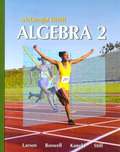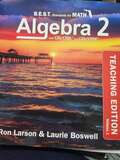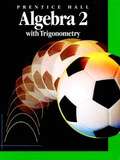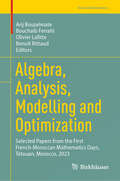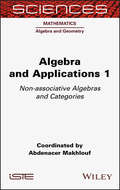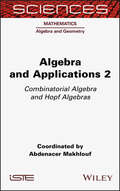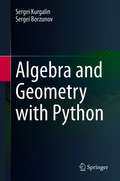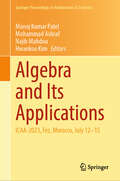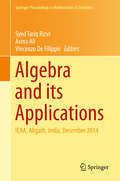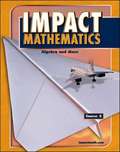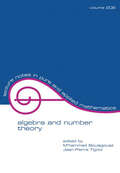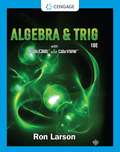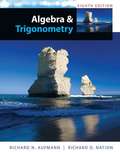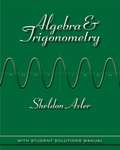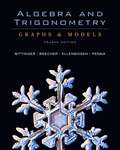- Table View
- List View
Algebra 2 (Illinois)
by Ron Larson Laurie Boswell Timothy D. Kanold Lee StiffContains fully worked-out solutions to all of the odd-numbered exercises in the text, giving students a way to check their answers and ensure that they took the correct steps to arrive at an answer.
Algebra 2 (Missouri)
by Ron Larson Laurie Boswell Timothy D. Kanold Lee StiffContains fully worked-out solutions to all of the odd-numbered exercises in the text, giving students a way to check their answers and ensure that they took the correct steps to arrive at an answer.
Algebra 2 (Ohio)
by Ron Larson Laurie Boswell Timothy D. KanoldContains fully worked-out solutions to all of the odd-numbered exercises in the text, giving students a way to check their answers and ensure that they took the correct steps to arrive at an answer.
Algebra 2 (Oklahoma)
by Carter Cuevas DayTHE PROGRAM STUDENTS NEED; THE FOCUS TEACHERS WANT! Glencoe Algebra 2 is a key program in our vertically aligned high school mathematics series developed to help all students achieve a better understanding of mathematics and improve their mathematics scores on today's high-stakes assessments.
Algebra 2 (Oklahoma)
by Ron Larson Laurie Boswell Timothy D. KanoldContains fully worked-out solutions to all of the odd-numbered exercises in the text, giving students a way to check their answers and ensure that they took the correct steps to arrive at an answer.
Algebra 2, Student Text and Homework Helper
by Randall I. Charles Allan E. Bellman Basia HallNIMAC-sourced textbook
Algebra 2 Teaching Edition Volume 2 B.e.s.t Standards Florida with Chitchat and CalcView
by Ron Larson Laura BoswellAlgebra 2 Teaching Edition Volume 2 B.e.s.t Standards Florida with Chitchat and CalcView
Algebra 2/Trigonometry Regents Review
by Topical Review Book Co. StaffA practice test booklet which contains the most recent NYS Regents as well as a series of full length practice tests patterned after the actual NYS Core Curriculum for Integrated Algebra 2/ Trigonometry.
Algebra 3: Homological Algebra and Its Applications (Infosys Science Foundation Series)
by Ramji LalThis book, the third book in the four-volume series in algebra, deals with important topics in homological algebra, including abstract theory of derived functors, sheaf co-homology, and an introduction to etale and l-adic co-homology. It contains four chapters which discuss homology theory in an abelian category together with some important and fundamental applications in geometry, topology, algebraic geometry (including basics in abstract algebraic geometry), and group theory. The book will be of value to graduate and higher undergraduate students specializing in any branch of mathematics. The author has tried to make the book self-contained by introducing relevant concepts and results required. Prerequisite knowledge of the basics of algebra, linear algebra, topology, and calculus of several variables will be useful.
Algebra 4: Lie Algebras, Chevalley Groups, and Their Representations (Infosys Science Foundation Series)
by Ramji LalThis book, the fourth book in the four-volume series in algebra, discusses Lie algebra and representation theory in detail. It covers topics such as semisimple Lie algebras, root systems, representation theory of Lie algebra, Chevalley groups and representation theory of Chevalley groups. Numerous motivating illustrations have been presented along with exercises, enabling readers to acquire a good understanding of topics which they can then use to find the exact or most realistic solutions to their problems.
Algebra, Analysis, Modelling and Optimization: Selected Papers from the First French-Moroccan Mathematics Days, Tétouan, Morocco, 2023 (Trends in Mathematics)
by Arij Bouzelmate Bouchaib Ferrahi Olivier Lafitte Benoît RittaudThis volume features selected papers presented at the first French-Moroccan Mathematics Days (F2MDays'23) held at the Abdelmalek Essaadi University, Morocco 2023. During these days, a variety of scientific activities involving training, workshops, and international conferences on scientific mediation, applied mathematics, innovation, and didactics of mathematics where held. The event provided an opportunity to build bridges between mathematical communities, reinforce existing international cooperation, and initiate new ones, hence contributing to the outreach of all involved parties.
Algebra and Applications 1: Non-associative Algebras and Categories
by Abdenacer MakhloufThis book is part of Algebra and Geometry, a subject within the SCIENCES collection published by ISTE and Wiley, and the first of three volumes specifically focusing on algebra and its applications. Algebra and Applications 1 centers on non-associative algebras and includes an introduction to derived categories. The chapters are written by recognized experts in the field, providing insight into new trends, as well as a comprehensive introduction to the theory. The book incorporates self-contained surveys with the main results, applications and perspectives. The chapters in this volume cover a wide variety of algebraic structures and their related topics. Jordan superalgebras, Lie algebras, composition algebras, graded division algebras, non-associative C*- algebras, H*-algebras, Krichever-Novikov type algebras, preLie algebras and related structures, geometric structures on 3-Lie algebras and derived categories are all explored. Algebra and Applications 1 is of great interest to graduate students and researchers. Each chapter combines some of the features of both a graduate level textbook and of research level surveys.
Algebra and Applications 2: Combinatorial Algebra and Hopf Algebras
by Abdenacer MakhloufThis book is part of Algebra and Geometry, a subject within the SCIENCES collection published by ISTE and Wiley, and the second of three volumes specifically focusing on algebra and its applications. Algebra and Applications 2 centers on the increasing role played by combinatorial algebra and Hopf algebras, including an overview of the basic theories on non-associative algebras, operads and (combinatorial) Hopf algebras.The chapters are written by recognized experts in the field, providing insight into new trends, as well as a comprehensive introduction to the theory. The book incorporates self-contained surveys with the main results, applications and perspectives. The chapters in this volume cover a wide variety of algebraic structures and their related topics. Alongside the focal topic of combinatorial algebra and Hopf algebras, non-associative algebraic structures in iterated integrals, chronological calculus, differential equations, numerical methods, control theory, non-commutative symmetric functions, Lie series, descent algebras, Butcher groups, chronological algebras, Magnus expansions and Rota–Baxter algebras are explored.Algebra and Applications 2 is of great interest to graduate students and researchers. Each chapter combines some of the features of both a graduate level textbook and of research level surveys.
Algebra and Geometry
by Alan F. BeardonDescribing two cornerstones of mathematics, this basic textbook presents a unified approach to algebra and geometry. It covers the ideas of complex numbers, scalar and vector products, determinants, linear algebra, group theory, permutation groups, symmetry groups and aspects of geometry including groups of isometries, rotations, and spherical geometry. The book emphasises the interactions between topics, and each topic is constantly illustrated by using it to describe and discuss the others. Many ideas are developed gradually, with each aspect presented at a time when its importance becomes clearer. To aid in this, the text is divided into short chapters, each with exercises at the end. The related website features an HTML version of the book, extra text at higher and lower levels, and more exercises and examples. It also links to an electronic maths thesaurus, giving definitions, examples and links both to the book and to external sources.
Algebra and Geometry with Python
by Sergei Kurgalin Sergei BorzunovThis book teaches algebra and geometry. The authors dedicate chapters to the key issues of matrices, linear equations, matrix algorithms, vector spaces, lines, planes, second-order curves, and elliptic curves. The text is supported throughout with problems, and the authors have included source code in Python in the book. The book is suitable for advanced undergraduate and graduate students in computer science.
Algebra and Its Applications: ICAA-2023, Fez, Morocco, July 12–15 (Springer Proceedings in Mathematics & Statistics #474)
by Manoj Kumar Patel Mohammad Ashraf Najib Mahdou Hwankoo KimThis volume contains selected chapters on algebra and related topics presented at the International Conference on Algebra and its Applications, held at the Department of Mathematics, Faculty of Science and Technology, Sidi Mohamed Ben Abdellah University, Fez, Morocco, from 12–15 July 2023, held in honour of Prof. Ayman Badawi and Prof. Abdelmoujib Benkirane. It contains a cross-section of topics in algebra and its applications which contribute to the development of pure and applied algebra. Chapters in the book focus on modern trends and techniques in various branches of pure and applied algebra and highlight their applications in several other branches of mathematics like coding theory, cryptography and graph theory. Covering a broad range of topics in pure and applied algebra, the book will be useful to a wide spectrum of researchers and graduate students in mathematics.
Algebra and its Applications: ICAA, Aligarh, India, December 2014 (Springer Proceedings in Mathematics & Statistics #174)
by Syed Tariq Rizvi Asma Ali Vincenzo De FilippisThis book discusses recent developments and the latest research in algebra and related topics. The book allows aspiring researchers to update their understanding of prime rings, generalized derivations, generalized semiderivations, regular semigroups, completely simple semigroups, module hulls, injective hulls, Baer modules, extending modules, local cohomology modules, orthogonal lattices, Banach algebras, multilinear polynomials, fuzzy ideals, Laurent power series, and Hilbert functions. All the contributing authors are leading international academicians and researchers in their respective fields. All the papers were presented at the international conference on Algebra and its Applications (ICAA-2014), held at Aligarh Muslim University, India, from December 15-17, 2014. The conference has emerged as a powerful forum offering researchers a venue to meet and discuss advances in algebra and its applications, inspiring further research directions.
Algebra and More, Course 3
by Faye Nisonoff RuoppA complete Algebra 1 curriculum by the end of the 8th grade IMPACT Mathematics: Algebra and More,Course 3 is part of an exciting 3-course program developed in cooperation withEducation Development Center, Inc. It makes mathematics accessible to more of your students. They spend less time reviewing topics from previous grades and more time progressing carefully and successfully toward the completion of Algebra 1 by the end of grade 8. Informal-to-formal concept development ensures that students build necessary skills and develop conceptual understanding.
Algebra And Number Theory
by M'Hammed Boulagouaz Jean-Pierre TignolThis study demonstrates the key manipulations surrounding Brauer groups, graded rings, group representations, ideal classes of number fields, p-adic differential equations, and rationality problems of invariant fields - displaying a command of the most advanced methods in algebra. It describes new developments in noncommutative valuation theory and
Algebra and Trig with CalcChat and CalcView
by Ron LarsonLarson's ALGEBRA AND TRIGONOMETRY incorporates real-world applications, ongoing review, and innovative technology. How Do You See It? exercises give you practice applying the concepts, and new Summarize features and Checkpoint problems reinforce understanding of the skill sets to help you better prepare for tests.
Algebra And Trigonometry
by Richard Aufmann Richard NationThe text also includes technology features to accommodate courses that allow the option of using graphing calculators. The authors' proven Aufmann Interactive Method allows students to try a skill as it is presented in example form.
Algebra And Trigonometry
by Sheldon AxlerAxler Algebra & Trigonometry is written for the two semester course. The text provides students with the skill and understanding needed for their coursework and for participating as an educated citizen in a complex society. Axler Algebra & Trigonometry focuses on depth, not breadth of topics by exploring necessary topics in greater detail. Readers will benefit from the straightforward definitions and plentiful examples of complex concepts. The Student Solutions Manual is integrated at the end of every section. The proximity of the solutions encourages students to go back and read the main text as they are working through the problems and exercises. The inclusion of the manual also saves students money.
Algebra and Trigonometry: Graphs and Models (4th Edition)
by Marvin L. Bittinger Judith A. Beecher David J. Ellenbogen Judith A. PennaThis book is for courses in algebra and trigonometry. Side-by-side algebraic and graphical solutions, the Visualizing the Graph and the Connecting the Concepts features, the Vocabulary Reviews, the Classify the Function exercises, and the Study Tips are included in this book to enable you make the most of your study time and to be successful in this course.
